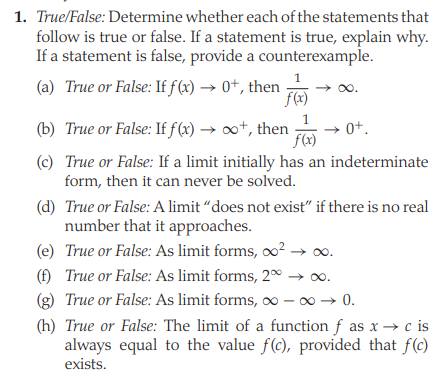1. True/False: Determine whether each of the statements that follow is true or false. If a statement is true, explain why. If a statement is false, provide a counterexample. 1 (a) True or False: If f (x) → 0+, then f(x) 0o. (b) True or False: If f(x) → ∞*, then f(x) → 0+. (c) True or False: If a limit initially has an indeterminate form, then it can never be solved. (d) True or False: A limit “does not exist" if there is no real number that it approaches. (e) True or False: As limit forms, o² → o. (f) True or False: As limit forms, 2º → 00. (g) True or False: As limit forms, ∞ - 0 → 0. (h) True or False: The limit of a function f as x → c is always equal to the value f(c), provided that f(c) exists.
1. True/False: Determine whether each of the statements that follow is true or false. If a statement is true, explain why. If a statement is false, provide a counterexample. 1 (a) True or False: If f (x) → 0+, then f(x) 0o. (b) True or False: If f(x) → ∞*, then f(x) → 0+. (c) True or False: If a limit initially has an indeterminate form, then it can never be solved. (d) True or False: A limit “does not exist" if there is no real number that it approaches. (e) True or False: As limit forms, o² → o. (f) True or False: As limit forms, 2º → 00. (g) True or False: As limit forms, ∞ - 0 → 0. (h) True or False: The limit of a function f as x → c is always equal to the value f(c), provided that f(c) exists.
College Algebra (MindTap Course List)
12th Edition
ISBN:9781305652231
Author:R. David Gustafson, Jeff Hughes
Publisher:R. David Gustafson, Jeff Hughes
Chapter3: Functions
Section3.3: More On Functions; Piecewise-defined Functions
Problem 99E: Determine if the statemment is true or false. If the statement is false, then correct it and make it...
Related questions
Question

Transcribed Image Text:1. True/False: Determine whether each of the statements that
follow is true or false. If a statement is true, explain why.
If a statement is false, provide a counterexample.
1
(a) True or False: If f (x) → 0+, then
f(x)
0o.
(b) True or False: If f(x) → ∞*, then
f(x)
→ 0+.
(c) True or False: If a limit initially has an indeterminate
form, then it can never be solved.
(d) True or False: A limit “does not exist" if there is no real
number that it approaches.
(e) True or False: As limit forms, o² → o.
(f) True or False: As limit forms, 2º → 00.
(g) True or False: As limit forms, ∞ - 0 → 0.
(h) True or False: The limit of a function f as x → c is
always equal to the value f(c), provided that f(c)
exists.
Expert Solution
This question has been solved!
Explore an expertly crafted, step-by-step solution for a thorough understanding of key concepts.
This is a popular solution!
Trending now
This is a popular solution!
Step by step
Solved in 2 steps

Recommended textbooks for you

College Algebra (MindTap Course List)
Algebra
ISBN:
9781305652231
Author:
R. David Gustafson, Jeff Hughes
Publisher:
Cengage Learning

Algebra & Trigonometry with Analytic Geometry
Algebra
ISBN:
9781133382119
Author:
Swokowski
Publisher:
Cengage


College Algebra (MindTap Course List)
Algebra
ISBN:
9781305652231
Author:
R. David Gustafson, Jeff Hughes
Publisher:
Cengage Learning

Algebra & Trigonometry with Analytic Geometry
Algebra
ISBN:
9781133382119
Author:
Swokowski
Publisher:
Cengage


College Algebra
Algebra
ISBN:
9781305115545
Author:
James Stewart, Lothar Redlin, Saleem Watson
Publisher:
Cengage Learning

Algebra: Structure And Method, Book 1
Algebra
ISBN:
9780395977224
Author:
Richard G. Brown, Mary P. Dolciani, Robert H. Sorgenfrey, William L. Cole
Publisher:
McDougal Littell